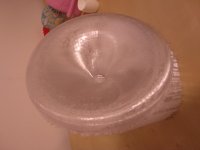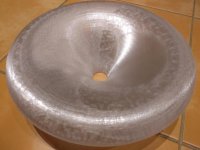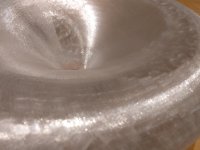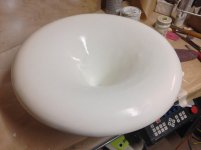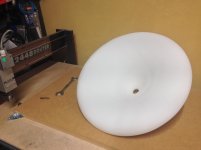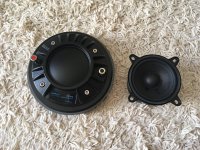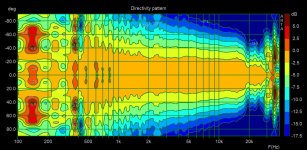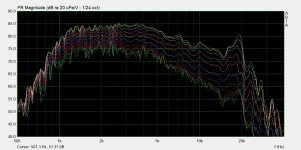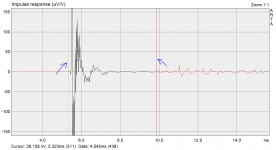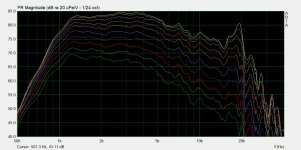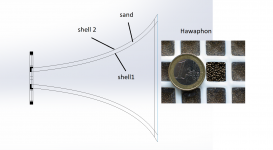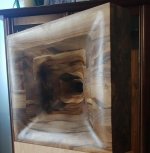This is the second attempt of the ST260 printed with 0.8mm nozzle (stock Prusa MK3S), PETG, ~27 hours. It was printed in the enclosure, because the previous attempt had shifted top layers from not really obvious reason. I also added more support and changed to honeycomb support, because it is very tall and the rectangular one bents.
Disadvantage of the honeycomb support is it is pain to get rid off.
I will print one more and try adding more infill (in one part the external layer is very thin) and lower the the external perimeter speed.
Disadvantage of the honeycomb support is it is pain to get rid off.
I will print one more and try adding more infill (in one part the external layer is very thin) and lower the the external perimeter speed.
Attachments
I don't understand the point at all.
What should be the use?
Me neither.
Science these days appears to be focused on "publications" instead of structured working towards higher goals.
Overall, this seems like a more advanced method:
Highlights
• Shape optimization of acoustic devices based on boundary discretization only.
• Accurate doubly-asymptotic boundary conditions avoid artificial reflection.
• Shape optimization of a metamaterial design for a wide range of frequencies.
• Demonstration of the metamaterial’s frequency response contraction and expansion.
• Optimization of an acoustic horn speaker using one to five design variables.
Unfortunately, the article is probably too recent and therefore stored on isolated severs, so it's not yet "accessible".
Last edited:
Mine 260 printed in about 10 hours in PETG with 0.5 mm nozzle on a Prusa style printer. Supports were needed only below the middle part. I would like to try a larger one in CNC'd layers one day.
Looking good gentlemen.
One more coat and they'll be done. Work by Jzagaja.
One more coat and they'll be done. Work by Jzagaja.
Attachments
Last edited:
Very smooth, looks great Mindsource, could you post about your putty/paint finish steps. Thanks
Thanks JSS. Jzagaja would be the person to answer that, since he is the one fabricating them.
I don't understand the point at all.
What should be the use?
I agree. A quick scan would indicate a "so-what?" It's obvious to me what the shape would converge to if they were to use far-far more convergent points - say broad-band? None of us would be surprised.
The Beyma CD14fe arrived today. Here's one next to a FaitalPro 3FE25 for scale.
Will make a little support for under it that will sit atop the woofer cabinet to take the weight. (It's heavy)
Will make a little support for under it that will sit atop the woofer cabinet to take the weight. (It's heavy)
Attachments
Last edited:
Tried my hand at some measurements. I am not the best with the ARTA software... One thing for sure the BMS 4552nd has quite a peak on the high end!
As far as I can tell this ST260-30 (ST252-30) waveguide is a winner!
I included a zip of the 0-90 degree pir files if anyone would care to have a look/offer advice.
Think I will go ahead and print a second waveguide and put them in a listenable system.
Thanks again mabat!
As far as I can tell this ST260-30 (ST252-30) waveguide is a winner!
I included a zip of the 0-90 degree pir files if anyone would care to have a look/offer advice.
Think I will go ahead and print a second waveguide and put them in a listenable system.
Thanks again mabat!
Attachments
Good question. I did smooth the measurements at 1/24 octave so some roughness is to be expected. Also like I said I am not experienced with ARTA. I have not learned how the gating works.
Thanks for the info @jzagajaIt's Pattex filler and wet charcoal paint. Below dried.
Nice CNC you have there, Do you do horns with it?
I'm thinking of going large, 3d print 3/4 of the horn on my chiron and cnc the mouth round over, could go 1-meter wide. It'll be a nice project for the summer lol
In the impulse response window, set the start of the gate with the left mouse button just before the impulse starts, and the end of it with the right mouse button just before the first strong room reflection arrives.Good question. I did smooth the measurements at 1/24 octave so some roughness is to be expected. Also like I said I am not experienced with ARTA. I have not learned how the gating works.
Attachments
Thank you for that mabat. I had found that last night just before heading to sleep. Redid with proper gating and it looks much much better.
Overall a pretty rough looking tweeter above 5khz. Going to compare with the three other 4552nd I have and see how they all compare. Also run a couple other waveguides while I have everything set up.
I feel this definitely adds another measured data set that matches the simulation. Marcel I do think your tool is working.
Overall a pretty rough looking tweeter above 5khz. Going to compare with the three other 4552nd I have and see how they all compare. Also run a couple other waveguides while I have everything set up.
I feel this definitely adds another measured data set that matches the simulation. Marcel I do think your tool is working.

Attachments
Thanks for the info @jzagaja
Nice CNC you have there, Do you do horns with it?
I'm thinking of going large, 3d print 3/4 of the horn on my chiron and cnc the mouth round over, could go 1-meter wide. It'll be a nice project for the summer lol
It's old Vision 2448 engraver but supported by Vectric Aspire - very easy soft. I like analog speed control with knobs. Controller is from 90s. So far made one walnut waveguide for a friend below:
Attachments
- Home
- Loudspeakers
- Multi-Way
- Acoustic Horn Design – The Easy Way (Ath4)
